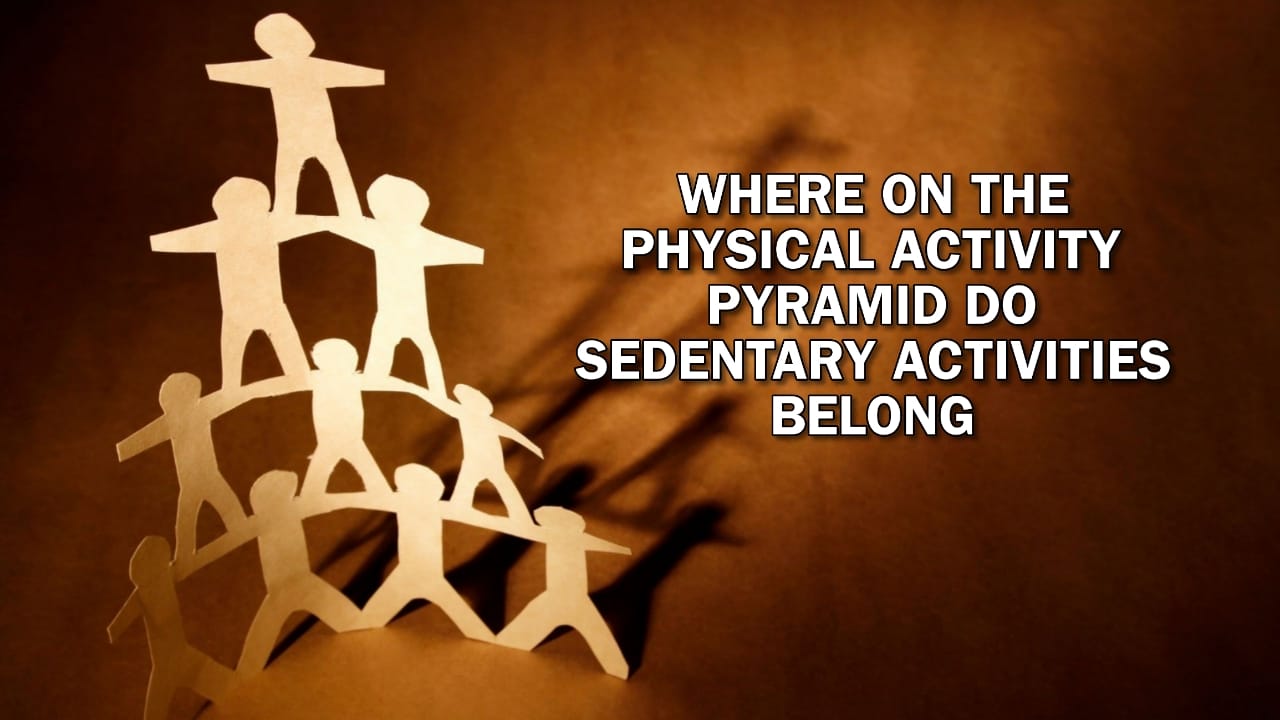Ever stood in front of a mirror and thought about getting more active but felt lost on where to start? You’re not alone. Many of us know we need to move our bodies more but figuring out how can feel like solving a puzzle without the picture box.
Here’s a fun fact: sedentary activities, like binge-watching your favorite show or scrolling through social media for hours, don’t have a place on the Physical Activity Pyramid. Surprised?.
This article is your roadmap through the maze of physical activity classification—no jargon, I promise. We’ll explore each level of the Physical Activity Pyramid and discover why sitting too much doesn’t make the cut.
Ready for a clearer path to improving your health? Keep reading!
Understanding the Physical Activity Pyramid

Imagine a pyramid, not filled with mummies and treasures, but jam-packed with actions and movements that keep you hopping, stretching, and lifting. This isn’t your average tour through Egypt; it’s the guide to moving your body right – welcome to understanding the Physical Activity Pyramid.
Development and purpose of the pyramid
The Park Nicollet Medical Foundation cooked up the Physical Activity Pyramid, like a master chef crafting the perfect recipe for health and fitness. Think of it as your GPS for weaving physical exercises into your daily routine, minus the annoying “recalculating” voice when you take a wrong turn.
This pyramid isn’t about piling on the carbs; it’s all about stacking up activities that get your heart pumping and muscles moving to fend off those sneaky health villains – obesity, high blood pressure, and even strokes.
Its purpose? To be a beacon of light in the murky waters of sedentary lifestyles. With this guide, choosing to hike or bike instead of binge-watching TV becomes less about guilt-tripping and more about making informed lifestyle choices.
It nudges you gently (okay, sometimes firmly) towards a path where regular physical activity buddies up with balanced diets and adequate sleep—a trifecta of good health no villain can knock down easily.
Importance of physical activities for overall health
Regular physical activities are like magic beans for health. They keep the heart happy, muscles dancing, and extra pounds at bay. Just picture this: a world where everyone brisk walks instead of sitting all day could mean fewer doctor visits.
Engaging in aerobic activities, strength training, or just playing tag can push away scary words like obesity, cardiovascular diseases, and even depression.
Imagine kids doing cartwheels or cycling their way to school. That’s not just fun; it’s building warriors against future ailments. Plus, hitting the 60 minutes mark of moving daily makes them less likely to become couch potatoes.
It’s about creating a lifestyle filled with joyful leaps rather than slow drags – ensuring bones grow strong and minds stay sharp. Let’s face it; active lives craft stories worth telling – ones with fewer sick days and more playground tales.
Levels of the Physical Activity Pyramid
Imagine climbing a pyramid, but instead of ancient stones, it’s made of your everyday hustle—sounds fun, right? Each level we step up takes us closer to being the star of our own fitness saga, from strolling in the park to lifting heavy weights like we’re superheroes.
Base level: Everyday activities
Kids today really hit the jackpot, didn’t they? They get encouraged to walk the dog, tackle the stairs like mini athletes, and trek to school—all in the name of health. This all goes down at the base level of the Physical Activity Pyramid.
It’s not about marathon running or lifting heavy weights. No, it’s grabbing those sneakers for a simple stroll to class or playing tag during recess. And let’s not forget—a solid hour of fun games keeps everyone ticking just right.
Avoiding being a couch potato for more than two hours daily is also part of this deal. Think about it—less screen time means more playtime! Who knew that chasing your furry friend around could be your ticket to staying fit? Plus, joining clubs at school isn’t just about making friends; it doubles as your secret fitness routine.
Sneaky yet brilliant!
Second tier: Moderately intense activities
Cycling, swimming, and dancing take center stage in the second tier of the Physical Activity Pyramid. They’re like the heart-pumping cousins of a lazy Sunday walk but aren’t as intense as running a marathon.
Each pedal on the bike, stroke in the pool, or step on the dance floor adds up to major health wins—think less risk of heart disease and obesity. Plus, they slot right into daily life without needing superhero endurance.
These activities are not just good for your body; they keep chronic diseases at bay. Imagine warding off villains like cardiovascular diseases and strokes with every swim lap or dance move—that’s what these moderately intense activities offer.
Keeping fit while having fun? Count us in for that jive!
Third tier: Highly vigorous activities
Highly vigorous activities make you breathe hard and your heart beat fast. Running, jumping rope, and basketball are perfect examples. They’re like the superheroes of the Physical Activity Pyramid, saving the day by boosting your cardiorespiratory fitness and muscle strength.
Kids need to hit at least 60 minutes of this action-packed fun daily. It’s not just about breaking a sweat; these activities help bones grow strong, muscles bulk up, and flexibility increase.
Think of it as essential training for young champs – with every jump shot or sprint, they’re becoming healthier versions of themselves.
Fourth level: Strength-building exercises
Lifting weights isn’t just for bodybuilders. Everyone should add strength exercises to their routine at least twice a week, and here’s why. These workouts boost muscle strength and endurance, putting the brakes on obesity and heart diseases.
Imagine giving your body the armor it needs—through weight training or resistance exercises—to fight off these health villains.
Picturing yourself doing push-ups or lifting heavy stuff might seem more like a chore than fun. But think of it as investing in your health’s savings account, with high returns in fitness and vitality.
Plus, who doesn’t enjoy the feeling of being strong enough to open that stubborn jar without help? It’s not just about building muscles; it’s about crafting a healthier lifestyle where picking up groceries or climbing stairs feels like a breeze rather than an Olympic event.
Fifth level: Flexibility exercises
Flexibility exercises grab the spotlight at the fifth level of our Physical Activity Pyramid. Picture this: stretching under a blue sky or doing yoga in a calm, serene room. It’s not just about being able to touch your toes; it’s about enhancing bone health and muscle strength too.
Including flexibility activities like pilates and gymnastics into your routine at least twice a week can make a world of difference. Imagine bending, reaching, and twisting with more ease than ever before.
These exercises serve as your body’s tune-up—kind of like oiling the hinges on a creaky door. They ensure that movements are smooth, reducing soreness and risks of injury. Whether you’re aiming for those impressive splits or just wanting to reach higher shelves without pulling something, incorporating flexibility workouts is key.
Don’t let stiff muscles hold you back from enjoying life’s simple pleasures like picking up dropped keys without groaning!
Sedentary Activities and their Exclusion from the Pyramid
Sedentary activities, you know—like morphing into a couch potato for marathon TV sessions or letting hours evaporate while scrolling through social media. These champions of inactivity are nowhere to be found on the Physical Activity Pyramid.
Why? Simple—they bring zilch to the party when it comes to boosting our health and fitness. Imagine trying to sneak them onto any level of that pyramid; they’d stick out like sore thumbs! They’re not just excluded; they’re effectively persona non grata because, let’s face it, lounging for too long is the antithesis of getting your heart rate up or building those muscles.
It’s kind of ironic, considering how much time we all can spend sitting down, whether it’s being glued to our desks for work or vegging out at home. The experts were clear—they drew a line in the sand that sedentary behaviors don’t mesh with healthier living goals.
Instead of earning a spot on this prestigious pyramid, these activities got ghosted because they contribute more to waistlines than well-being. Recommendations shout loud and clear: swap out some sitting time for anything—literally anything—that gets you moving.
Whether it’s choosing stairs over elevators or taking brisk walks instead of binge-watching another series—you’re making strides towards fitting into those tiers packed with lifestyle activities and aerobic workouts designed for a fitter you.
Recommendations for Adults and Children

Adults, aim for at least 150 minutes of that heart-pumping, sweat-dripping moderate-intensity activity each week—yes, the kind that makes you rethink your life choices mid-jog. Kids and teens? They’re not off the hook—shoot for an hour a day of moving more and sitting less, because let’s face it, those video games won’t miss them too much.
Minimum requirements for moderate-intensity physical activity
Get moving with at least 150 to 300 minutes of moderate-intensity physical activity each week. This can include anything from brisk walking, biking, or even heavy gardening. It’s like hitting two birds with one stone—achieving your fitness goals while enjoying the great outdoors or ticking off chores on your to-do list.
Don’t forget about those muscles! Incorporate muscle-strengthening activities twice a week. Think weight lifting, resistance training, or calisthenics. These aren’t just for show—they’re essential for overall health and keeping you fit as a fiddle.
Plus, it’s practically an invitation to mix things up and keep boredom at bay.
Recommendations for children and adolescents
Kids and teens need to hit at least 60 minutes of physical activity every day. Think running, jumping, or any heart-pumping action that gets them off the couch. It’s not just about keeping fit; they’re building stronger bones and muscles too.
Throw in some fun stuff like skateboarding or swimming twice a week for a top-notch health boost.
Also, aim for activities that crank up their happiness meter—because let’s face it, if it’s not fun, why bother? This can mean dance-offs in the living room or a family hiking adventure on weekends.
Keeping active is crucial for young ones to grow up healthy and strong—with bonus points for ditching screen time for more playtime!
The Importance of Lifestyle Activities
Lifestyle activities are the unsung heroes of our daily routine, sneaking in those health benefits while we’re none the wiser. They’re like ninjas fighting off laziness and bad habits, making a big impact in the long run without us even noticing.
Addressing misconceptions and barriers
Many of us have chuckled at the idea that running after a runaway napkin in a park counts as exercise. Yet, here’s the twist – such lifestyle activities can be crucial for our overall health and weight management.
We often hear whispers (okay, loud voices) telling us there’s just no time, motivation feels like finding a unicorn, and the benefits of physical activity sound like legends from old books.
However, these everyday movements matter more than we think.
Picture this: choosing stairs over elevators on Monday can feel heroic; by Friday, it seems mundane. But each step contributes to cardiovascular health and fits into that well-balanced way of life we keep hearing about from fitness gurus and registered dietitian nutritionists alike.
Barriers crumble when we chuckle at ourselves huffing up those stairs or racing that napkin – not because we’re becoming marathon runners overnight but because these moments add up in the quest for better health without needing heavy weight lifting or hitting max heart rate targets daily.
Role of lifestyle activities in maintaining overall health and wellness
Lifestyle activities are like the unsung heroes of our daily routines, quietly playing a key role in keeping us fit and fabulous. Think walking the dog, taking the stairs instead of the elevator, or dancing around your living room—yes, even that counts! These aren’t just random moments; they’re building blocks for overall health and wellness.
They add up, combating sedentary pitfalls and boosting everything from heart rates to mental health.
Experts shout it from the rooftops: kids and teens need at least 60 minutes of moderate to vigorous physical activity every day. But let’s face it, between school work and screen time, that’s easier said than done.
The secret sauce? Variety and consistency with lifestyle activities—they break down barriers like lack of time or motivation by making fitness fun and accessible. Plus, they inject a dose of much-needed aerobic activity into our lives without feeling like a choreographed exercise routine straight out of an ’80s workout video.
Conclusion
Sedentary activities, they’re the loners of the Physical Activity Pyramid world. Imagine them lurking outside the pyramid, not quite fitting in with those active tiers. They don’t get a spot because, well, sitting around isn’t what gets our hearts racing or muscles flexing.
We need to move more and sit less – advice that sounds simple but is oh-so-tricky to follow in our couch-loving, binge-watching culture. Yet, embracing those higher pyramid levels could be the key to unlocking a healthier life.
So let’s shake off that sedentary lifestyle and climb up the pyramid—one active choice at a time.





























